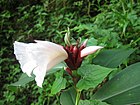Note: This is a project under development. The articles on this wiki are just being initiated and broadly incomplete. You can Help creating new pages.
Difference between revisions of "Cheilocostus speciosus - Kebuka"
(→How to plant/cultivate) |
(→List of Ayurvedic medicine in which the herb is used) |
||
| Line 45: | Line 45: | ||
==List of Ayurvedic medicine in which the herb is used== | ==List of Ayurvedic medicine in which the herb is used== | ||
| − | *[[Kṛmighna Kvātha Cūrṇa]] | + | * [[Kṛmighna Kvātha Cūrṇa]] |
| + | * [[Asana eladi taila]] | ||
| + | * [[Nisoshiradi taila]] | ||
| + | * [[Brihat Purnachandra rasa]] | ||
| + | <ref name="Ayurvedic properties"/> | ||
==Where to get the saplings== | ==Where to get the saplings== | ||
Revision as of 17:50, 4 June 2019
Kebuka consists of the dried rhizome of Costus speciosus (Koerning ex Retz.) Smith. (Fam. Zingiberaceae), a herb commonly found in sub-Himalayan tract extending between Kangra to Arunachal Pradesh and also in Western Ghats.
Contents
- 1 Uses
- 2 Parts Used
- 3 Chemical Composition
- 4 Common names
- 5 Properties
- 6 Habit
- 7 Identification
- 8 List of Ayurvedic medicine in which the herb is used
- 9 Where to get the saplings
- 10 Mode of Propagation
- 11 How to plant/cultivate
- 12 Commonly seen growing in areas
- 13 Photo Gallery
- 14 References
- 15 External Links
Uses
Fever, Rash, Bronchitis, Asthma, Intestinal worms, Kidney problems, Urinary problems.
Parts Used
Chemical Composition
Steroidal Saponins such as (Tigogenin and diosgenin).[1]
Common names
| Language | Common name |
|---|---|
| Kannada | Chenglavaa-Koshtu, Changalvakoshtu |
| Hindi | Kebu, Kemuk, Kemuaa |
| Malayalam | Channakkilannu, Channakkuvva |
| Tamil | Koshtam |
| Telugu | Chenglavaa-Koshtu |
| Marathi | NA |
| Gujarathi | NA |
| Punjabi | NA |
| Kashmiri | NA |
| Sanskrit | Pushkarmula |
| English |
Properties
Reference: Dravya - Substance, Rasa - Taste, Guna - Qualities, Veerya - Potency, Vipaka - Post-digesion effect, Karma - Pharmacological activity, Prabhava - Therepeutics.
Dravya
Rasa
Tikta
Guna
Rūkṣa, Laghu
Veerya
Śīta
Vipaka
Kaṭu
Karma
Pittahara, Kaphahara, Dīpana, Pācana, Grāhī, Kṛmighna, Hṛdya, Raktaṣodhaka
Prabhava
Habit
Identification
Leaf
| Kind | Shape | Feature |
|---|---|---|
| Paripinnate | Oblong | Leaf Arrangementis Alternate-spiral |
Flower
| Type | Size | Color and composition | Stamen | More information |
|---|---|---|---|---|
| Unisexual | 2-4cm long | pink | Flowering throughout the year and In terminal and/or axillary pseudoracemes |
Fruit
| Type | Size | Mass | Appearance | Seeds | More information |
|---|---|---|---|---|---|
| oblong pod | Thinly septate, pilose, wrinkled | seeds upto 5 | Fruiting throughout the year |
Other features
List of Ayurvedic medicine in which the herb is used
Where to get the saplings
Mode of Propagation
How to plant/cultivate
C. speciosus are usually grown in fertile, organic, moist, well-drained soils in shade. Tropical climate with high humidity and minimum temperature 13o C is best for its cultivation. Crepe ginger grows from thick fleshy roots called "rhizomes".[4]
Commonly seen growing in areas
Roadside ditches, Low-lying areas in the forest.
Photo Gallery
References
- ↑ The Ayuredic Pharmacopoeia of India Part-1, Volume-5, Page no-12
- ↑ [ "Morphology"]
- ↑ Cite error: Invalid
<ref>tag; no text was provided for refs namedAyurvedic properties - ↑ "Cultivation detail"
External Links
- Pages with reference errors
- Ayurvedic Herbs known to be helpful to treat Fever
- Ayurvedic Herbs known to be helpful to treat Rash
- Ayurvedic Herbs known to be helpful to treat Bronchitis
- Ayurvedic Herbs known to be helpful to treat Asthma
- Ayurvedic Herbs known to be helpful to treat Intestinal worms
- Ayurvedic Herbs known to be helpful to treat Kidney problems
- Ayurvedic Herbs known to be helpful to treat Urinary problems
- Herbs with Rhizome used in medicine
- Herbs with common name in Kannada
- Herbs with common name in Hindi
- Herbs with common name in Malayalam
- Herbs with common name in Tamil
- Herbs with common name in Telugu
- Herbs with common name in Sanskrit
- Habit - Perennial shrub
- Index of Plants which can be propagated by Seeds
- Herbs that are commonly seen in the region of Roadside ditches
- Herbs that are commonly seen in the region of Low-lying areas in the forest
- Herbs
- Costaceae






